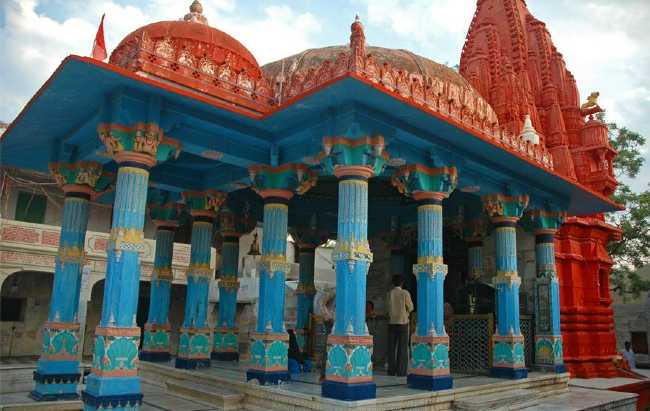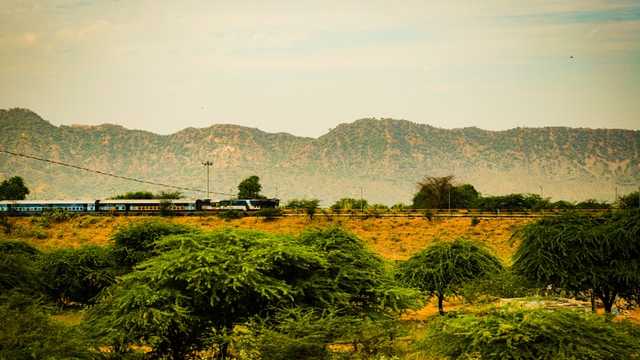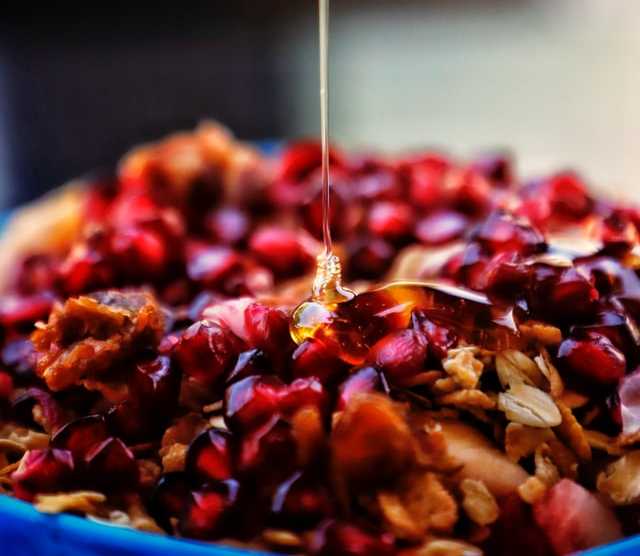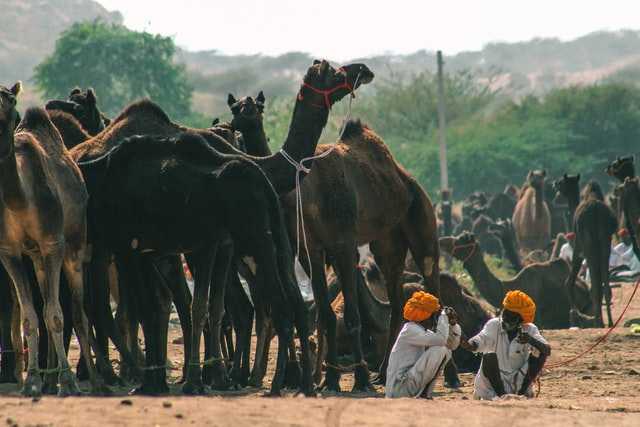Pushkar is one of the oldest cities in India. Situated in the Ajmer district of Rajasthan amidst the Aravalli range, Pushkar is often referred to as Tirtha-raj, which literally means the king of pilgrimage sites.
It is one of the five pilgrimage sites for people following Hinduism. There are many temples in Pushkar and the most famous temple is the Brahma Temple. Pushkar is also famous for the lake, which has 52 ghats.
Rajasthan is also most famous as the land of kings, queens, and palaces, but for the travelers, it is also a place where many religious places are present.
It is believed that Pushkar was created by Brahma, the Hindu god of creation himself, so it is bound to show religious significance here. If you are coming to Pushkar in search of beautiful architecture and religious solitude, then believe me the temples of Pushkar will make your heart happy.
The most famous Hindu temple is dedicated to Lord Brahma, who is considered the creator of the universe. Being the only temple dedicated to Brahma in India, it attracts lakhs of pilgrims every year.
The red spire and the image of a swan are the hallmarks of this temple. The inner sanctum sanctorum of the temple houses a four-faced idol of Lord Brahma.
Originally built in the 14th century, the Brahma Temple is believed to be 2000 years old. This temple remains open from 6.30 am to 8.30 pm. Brahma temple is only 10 km away from Ajmer city.
Table of Contents
History of Pushkar Temple
It is a matter of great surprise that this is the only temple of Brahmaji in the whole of India. While hundreds of temples of other Hindu deities are located in different places in India.
Why were many temples of Brahma not built like other gods and goddesses? And what was the curse that led to the construction of this temple?
The answer to these questions is related to an incident that happened many years ago, which is described in the Hindu scripture Padma Purana.
At that time a demon named Vajranash was harassing everyone on earth with his atrocities. To end his increasing atrocities, Brahmaji killed him.
When Brahmaji killed him, three lotus flowers fell at three different places in Pushkar, and lakes were formed at these places. These places are called Vyastha, Madhya, and Junior Pushkar.
After killing the thunderbolt, Brahma organized a Yagya in Pushkar. It was necessary for his wife to sit in this Yagya. All the gods and goddesses reached the place of Yagya, but Brahma’s wife Savitri did not reach.
They waited for a long time, but they did not arrive. Seeing the auspicious time coming out, Brahmaji married Gayatri, a Gurjar girl and she sat with him in the Yagya.
Meanwhile, Savitri reached the place of Yagya. There she got angry seeing Gayatri sitting with Brahma in the Yagya. He cursed Brahma that he would never be worshipped.
Lord Vishnu had helped Brahma, so he could not escape from Savitri’s anger. He was cursed to suffer the pain of separation from his wife. Therefore, Shri Ram, an incarnation of Lord Vishnu, had to live separately from his wife Sita during the exile of 14 years.
In a fit of anger, Savitri cursed Naradji to remain a bachelor for life. The brahmins who got Brahma and Gayatri married and the cows brought in the yajna also had to become a part of Savitri’s anger.

The Brahmin was cursed that no matter how much donation he gets, he will never be satisfied. Cows were cursed to eat dirt in Kali Yuga. Agnidev, who was contained in the fire pit of Yagya, got the curse of being humiliated in Kaliyuga.
When Savitri’s anger subsided, all the gods started apologizing to her and requested her to withdraw the curse, but Savitri did not agree.
While reducing the curse of Brahma, she simply said that Pushkar will be the only place on this earth where you will be worshipped.
After this, she went to the top of Pushkar’s Ratnagiri hill and became absorbed in penance. Today there is a temple of Savitri Devi at this place.
This temple is mainly built of stone slabs and marble. There is a swan at the entrance of the temple. The idols of Brahma ji and Mata Gayatri are installed inside the temple.
A fair is held on Kartik Purnima
Every year a fair is held in Pushkar on the day of Kartik Purnima. It is said that Lord Brahma performed a yajna at this place on the day of Kartik Purnima. Therefore, during the fair held on this occasion, devotees from different parts of the country reach the temple of Brahma to have darshan.
Brahma Temple Visiting Time
The opening time of the Brahma temple is different during the summer and winter seasons. In summer it is open from 5 am to 1:30 pm and from 3 pm to 9 pm. In winter it is open from 6 am to 1:30 pm and from 3 pm to 8:30 pm.
How to reach Brahma Temple?
By Rail – The nearest railway station to Pushkar is Ajmer. From where Pushkar can be reached by getting bus and cab facilities.

By Road – Although bus travel is not a good option to reach Pushkar from long distances. Still, a bus facility is available from Delhi to Ajmer and Ajmer to Pushkar, which is an option to reach here. Buses of Rajasthan Road Transport Corporation ply on this route regularly.
By Air – The nearest airport to Pushkar is Jaipur, which is 140 km away from Pushkar. After reaching Jaipur, one can reach Pushkar by cab and visit the Brahma temple.
Brahma Temple Construction & Architecture
The Brahma temple is located in Pushkar, which is called the Tirthraj of India. It is one of the major temples located in Pushkar. Information regarding when and by whom this temple was built is not available anywhere.
It is said that 2000 years from today, the king of the Aranya dynasty saw this temple in his dream. After that, he took care of it. However, later this temple was destroyed along with other temples by the Mughal emperor Aurangzeb. It was rebuilt in the 14th century.
Temples in Pushkar
Mahadev Temple in Pushkar
Situated on the banks of the Pushkar Lake in the heart of the city, the Mahadev Temple—also known as the Apteswar Mahadev Temple—is a popular Hindu pilgrimage site in the city of Pushkar. The temple has an idol of Lord Shiva with five faces which is made of marble and is embellished with beautiful ornaments.
These five faces are called Sadyojat, Vamadeva, Aghor, Tatpurush, and Ishaan. The sculptures and carvings around the main temple depict various Hindu deities. The temple was built in the 19th century and boasts a splendid architectural style.
In addition, there are many beautiful carvings and intricate decorations around the walls and pillars depicting Hindu gods and goddesses. The temple is open from 6 am to 8 pm and is 14 km away from Ajmer railway station.
Apteswar Temple is one of the religious places in India, which boasts mesmerizing architecture and religious rituals. One of the most visited temples in Rajasthan, Apteswar Temple is a perfect blend of splendid architecture and spiritual significance, attracting both tourists and devotees.
This 12th-century structure was destroyed by Aurangzeb but rebuilt. The main deity here is Shiva Lingam to which curd, milk, ghee, and honey are offered.
Shivratri is the main festival here, which is celebrated with great enthusiasm. It is located near Brahma temple and you can visit this temple from 6.30 am to 8.30 pm.
Varaha Temple in Pushkar
It is said that once a demon named Hiranyaksha was going to destroy all life on earth and threatened to destroy the planet. Seeing his action, Lord Vishnu appeared in the incarnation of half boar-half man and killed the demon.
At different times, when the forces of evil increased, Lord Vishnu incarnated to destroy them. According to Hindu mythology, he adopted nine such avatars, one of which was Varaha. This temple is dedicated to the Varaha avatar of Vishnu.
The Varaha temple was built by Raja Anaji Chauhan in the 12th century. In the inner sanctum sanctorum of the temple, there is a huge idol of Lord Varaha which is of white color. The best time to visit Varaha Temple is between October to February during winters. You can visit the temple anytime from sunrise to sunset.
Savitri Temple in Pushkar
According to Hindu mythology, Savitri Devi was the wife of Brahma and she was supposed to reach a yagna, which Brahma was performing, but she could not reach on time. In order to perform the Yagya in time, Brahma married a local girl named Gayatri, who then became Brahma’s second wife.
Due to all these things, Goddess Savitri became very angry. A temple of Savitri Devi was built to please him. Even today evening aarti is performed first in Savitri temple and then in Gayatri temple.
The idols of both the deities have been kept in the Savitri temple. Situated on the top of the hill, this temple is thronged by devotees even during all the major Hindu festivals throughout the year.
Rangji Temple in Pushkar
One of the most popular religious places in Pushkar, Old Rangji Temple is a 150-year-old temple dedicated to Lord Rangji, who is believed to be an incarnation of Lord Vishnu. You can see a beautiful blend of Mughal and Rajput architecture in the temple.
The old Rangji Temple is dedicated to Lord Ranga. The temple was built in the year 1823 by Seth Puran Mal Ganeriwal, a wealthy businessman from Hyderabad.
The temple has idols of Lord Rangji, idols of Lord Krishna, idols of Goddamhi, Goddess Lakshmi, and Sri Ramanujacharya.
This temple is open from 6 am to 7 pm and is close to Pushkar Lake.
Places to Visit in Pushkar
Pushkar is also known as the ‘Rose Garden of Rajasthan’, because of the floriculture in and around the city. These flowers are exported all over the world.

Surrounded by hills, Pushkar is a popular destination among devotees and tourists. In recent years, Pushkar has become one of the most famous tourist destinations among Indian and international tourists.
The annual Pushkar Camel Fair, held in November, draws a huge crowd. The spirituality and serenity will make you fall in love with Pushkar instantly. The beautiful architectural heritage and its interesting history make Pushkar a must-visit in India.
Man Mahal Pushkar
Built to serve as the guest house of Raja Man Singh, Man Mahal Palace is one of the largest palaces in Pushkar.
This palace is one of the most popular tourist places in the city. Man Mahal is a visual treat from the royal period with its grand Rajasthani architectural style.
This palace has now been converted into a heritage hotel and is called RTDC Hotel Sarovar.
The palace still retains its old-world charm. The heritage hotel is run by the Rajasthan Tourism Development Corporation.
The palace not only gives you a peek into the bygone era but also provides a splendid view of the lake and the surrounding areas.
The hotel will let you experience the essence of the royal hospitality of Rajasthan. Some of the hotel facilities include camping, camel carriage ride, tours of Pushkar Animal Fair, a tour of Pushkar Lake, and a camel ride.
The place also offers a range of recreational facilities including a restaurant, bar, spa, and transportation facilities.
Pushkar Camel Fair
The Pushkar Camel Fair, also known as the Kartik Mela, is one of the most beautiful camel festivals in the country. This festival is organized every year for 8 days in the month of November.
This fair is organized every year during the holy Kartik Purnima to encourage local camel and cattle traders to do business.

Many shops are set up on the fairgrounds, which feature Rajasthani handicrafts, art, and culture. Also, the best part of this fair is that each day of the fair includes activities including magical shows, snake charmers, puppet shows, camel parades, gypsy dance, and ghoomar.
Adventurous Activities in Pushkar: Thrills amidst Tranquility
Pushkar, known for its spiritual aura and cultural heritage, also offers a range of exciting adventurous activities for those seeking a thrilling experience. Explore the adventurous side of Pushkar with these exhilarating activities:
- Hot Air Ballooning: Soar high above the city and take in breathtaking views of Pushkar’s picturesque landscapes and the stunning Aravalli Range. Enjoy the serene tranquility as you float through the sky in a hot air balloon, creating unforgettable memories.
- Camel Safari: Embark on a camel safari and venture into the desert surrounding Pushkar. Traverse the golden sand dunes atop a camel, immersing yourself in the rustic charm of Rajasthan’s wilderness. Witness mesmerizing sunsets and experience the desert’s vastness in a unique and traditional way.
- Jeep Safari: Explore the rugged terrain and remote villages surrounding Pushkar with an exhilarating jeep safari. Journey through off-road tracks, witness stunning vistas, and discover the hidden gems of the desert landscape. It’s an adventure that offers both excitement and a glimpse into the local culture.
- Trekking: Lace up your boots and set off on a trekking adventure in the Aravalli hills near Pushkar. Follow scenic trails, breathe in the fresh air, and witness the natural beauty of the region. From easy hikes to more challenging routes, there are options available for all levels of trekkers.
- Zip-lining: Experience an adrenaline rush with zip-lining across Pushkar’s landscapes. Soar through the air, suspended on a zip line, and marvel at the panoramic views of the city, the surrounding hills, and the enchanting Pushkar Lake. It’s a thrilling activity that combines adventure and a bird’s-eye perspective.
- Rappelling and Rock Climbing: Test your skills and conquer the rugged cliffs and rock formations near Pushkar with rappelling and rock climbing. Feel the thrill of descending down steep cliffs or scaling vertical walls, surrounded by the natural beauty of the Aravalli Range.
- Quad Biking: Get ready for an action-packed adventure with quad biking in the desert terrain. Hop on an all-terrain vehicle and zoom through sandy tracks and undulating trails, experiencing the thrill of off-road biking in the heart of Pushkar’s wilderness.
- Paragliding: Soar through the skies like a bird and enjoy breathtaking aerial views of Pushkar with paragliding. Feel the rush of adrenaline as you glide above the city and surrounding landscapes, experiencing the freedom and beauty of flight.
Pushkar, with its serene surroundings and natural beauty, provides the perfect backdrop for adventurous activities. Whether you choose to float above in a hot air balloon, explore the desert on a camel safari, or engage in thrilling sports like zip-lining and rock climbing, Pushkar offers a unique blend of tranquility and excitement for adventure enthusiasts.
Get ready to embrace the adrenaline and immerse yourself in thrilling experiences that will create memories to last a lifetime.
Frequently Asked Questions (FAQs) about Pushkar, Rajasthan
1. Where is Pushkar located in Rajasthan?
Pushkar is located in the Ajmer district of Rajasthan, India. It is situated on the western side of the Aravalli Range, about 14 kilometers northwest of Ajmer city.
2. What is the significance of Pushkar?
Pushkar is considered one of the oldest cities in India and holds immense religious significance. It is regarded as a sacred pilgrimage site for Hindus due to the presence of the famous Pushkar Lake and the Brahma Temple. According to Hindu mythology, Lord Brahma, the creator of the universe, is said to have performed a ritual here.
3. Is Pushkar only known for its religious significance?
While Pushkar is primarily renowned for its religious importance, it also offers a unique blend of spirituality, culture, and vibrant festivities. The city attracts travelers with its colorful markets, camel fair, and the tranquil ambiance of its sacred lake.
4. What is the best time to visit Pushkar?
The best time to visit Pushkar is during the winter months, from October to March, when the weather is pleasant and suitable for exploring the city and participating in festivals. However, the period around the annual Pushkar Camel Fair, held in November, is a particularly lively and popular time to visit.
5. Can non-Hindus visit the temples in Pushkar?
Yes, non-Hindus are generally allowed to visit the temples in Pushkar. However, it is important to show respect for the religious customs and practices observed at these sacred sites. Modest attire and adherence to the rules and guidelines of the temple premises are appreciated.
6. What are the major attractions in Pushkar besides the temples?
Apart from the temples, Pushkar offers several attractions for visitors. The Pushkar Lake is a significant focal point, known for its sacredness and the ritual bathing ghats surrounding it. The Pushkar Camel Fair is a major highlight, featuring camel races, cultural performances, and a vibrant market. The Brahma Ghat, Savitri Temple, and the colorful bazaars are also worth exploring.
7. Are there any accommodation options in Pushkar?
Yes, Pushkar offers a wide range of accommodation options, catering to various budgets and preferences. Visitors can choose from luxury resorts, heritage hotels, guesthouses, and budget-friendly lodgings. It is advisable to book in advance, especially during the peak tourist season and festivals.
8. How can I reach Pushkar?
The nearest airport to Pushkar is the Jaipur International Airport, located approximately 150 kilometers away. From there, you can hire a taxi or take a bus to reach Pushkar. The Ajmer Junction railway station is the nearest major railhead, with frequent train connections. Pushkar is well-connected by road, and buses and taxis are available from nearby cities.
9. Can I take a dip in the Pushkar Lake?
Yes, the Pushkar Lake offers a sacred bathing experience for devotees and visitors. Taking a dip in the lake is considered a purifying ritual. However, it is advisable to respect the religious practices and follow any guidelines or instructions provided by the authorities.
10. Is it possible to attend the Pushkar Camel Fair as a visitor?
Yes, the Pushkar Camel Fair is open to visitors, and it provides a fascinating glimpse into the traditional rural life of Rajasthan. Visitors can witness various activities like camel trading, cultural performances, competitions, and enjoy the lively atmosphere of the fair.
Conclusion
In conclusion, Pushkar, Rajasthan, holds a significant place as a sacred pilgrimage site and a vibrant cultural destination. With its captivating temples, tranquil Pushkar Lake, and lively festivals, the city offers a unique blend of spirituality, tradition, and colorful festivities.
The religious importance of Pushkar is deeply rooted in Hindu mythology, with the presence of the revered Brahma Temple and the sacred Pushkar Lake. Pilgrims and visitors flock to the city to seek blessings, take holy dips in the lake, and immerse themselves in the spiritual ambiance.
Pushkar is not just a hub of religious activities; it also enchants visitors with its cultural richness and vibrant events. The Pushkar Camel Fair, held annually, is a mesmerizing spectacle of camel trading, cultural performances, and a bustling market. It provides a unique opportunity to witness the traditional rural life of Rajasthan.
Besides the temples and the fair, Pushkar offers a myriad of experiences, from exploring the picturesque ghats surrounding the lake to wandering through the vibrant bazaars, where one can find colorful textiles, jewelry, and handicrafts.
Accommodation options in Pushkar cater to a variety of preferences, ranging from luxurious resorts to budget-friendly guesthouses. It is advisable to book in advance, especially during the peak tourist season and festival periods.
Reaching Pushkar is convenient, with Jaipur International Airport being the closest airport and Ajmer Junction railway station serving as the major railhead. Road connectivity through buses and taxis from nearby cities makes it easily accessible for travelers.
Pushkar invites visitors of all backgrounds to experience its serene spirituality, participate in its vibrant celebrations, and soak in the cultural heritage of Rajasthan.
As you explore the temples, witness the rituals, and stroll along the ghats, let Pushkar’s aura embrace you, leaving you with cherished memories of this unique and sacred oasis in the heart of Rajasthan.